Honoring the Departed: The Significance of Funeral Procession Flags
Funeral flags for cars are specialized banners attached to vehicles participating in funeral processions to identify them as part of the motorcade, ensure procession cohesion, and symbolize respect for the deceased.
Here's what you need to know about funeral flags for cars:
- Purpose: Identify vehicles in a funeral procession and promote safety
- Standard Size: Typically 6" × 9" banners on 11" staffs
-
Common Types:
- Purple with white cross (traditional)
- Orange with black cross (high visibility)
- Star of David (Jewish services)
- American flag (military/veteran services)
- Mounting Options: Magnetic bases, window clips, or suction cups
- Average Cost: $11.40 to $230 per dozen, depending on quality and customization
These dignified markers serve a practical purpose while honoring time-honored mourning traditions. When properly displayed, they signal to other motorists that vehicles are part of a solemn procession that should not be interrupted.
The flags' colors and symbols carry specific meanings that align with cultural, religious, or personal preferences of the deceased and their family. Most funeral homes and procession organizers select designs that reflect the deceased's faith tradition or military service.
I'm Mortuary Cooler, a national-level supplier with extensive experience providing funeral flags for cars and other essential mortuary equipment to funeral professionals throughout the United States. My work with funeral directors has given me knowledge of how these dignified markers improve both the safety and ceremonial aspects of final journeys.
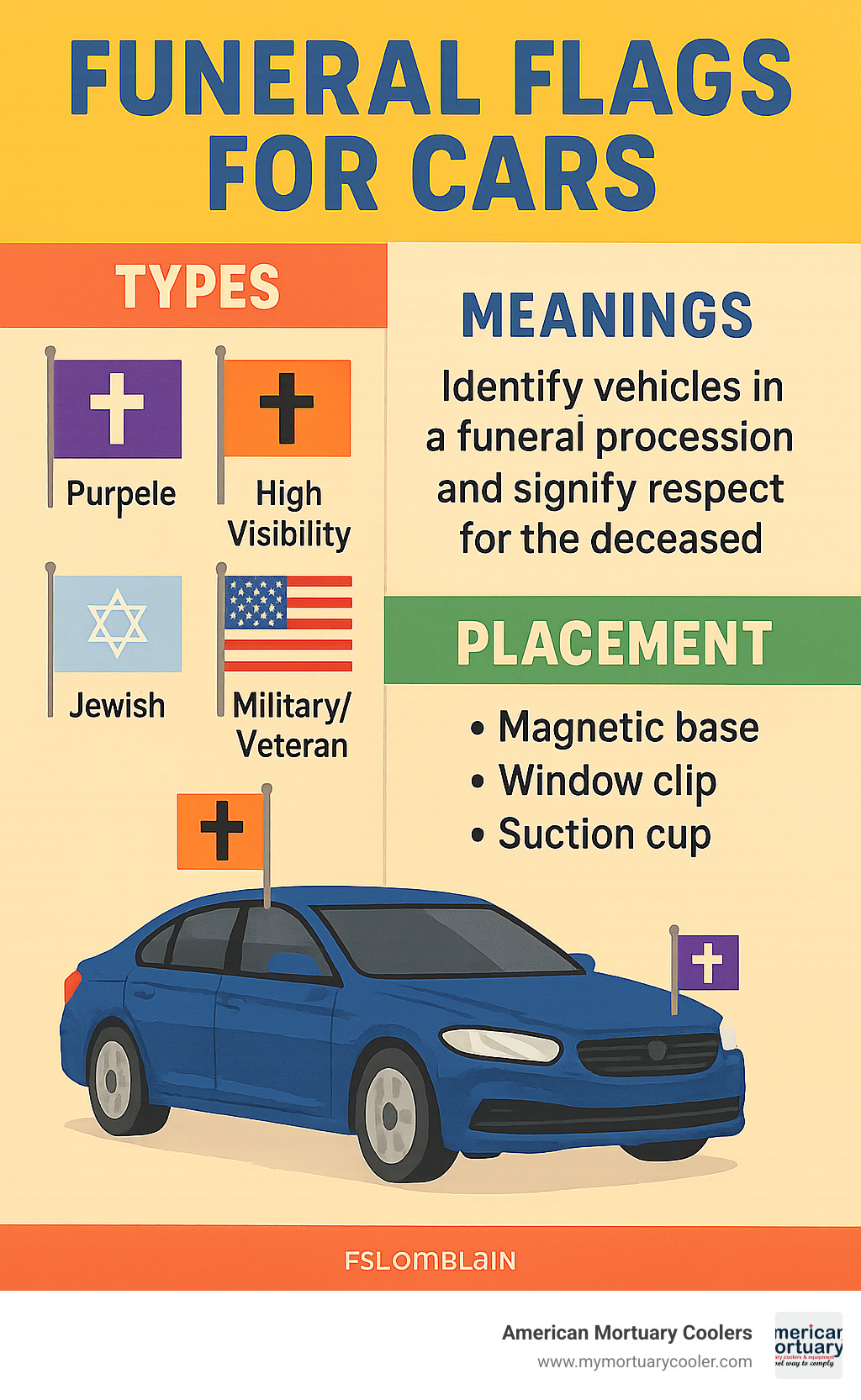
Funeral flags for cars word list:
Funeral Flags for Cars: Purpose, History & Symbolism
When you see a line of cars with small flags fluttering from their roofs, you're witnessing one of our oldest mourning traditions adapted for modern times. Funeral flags for cars create a visual thread connecting each vehicle in a procession, helping everyone stay together during the journey to the final resting place.
These flags serve a practical purpose first – they clearly identify which vehicles belong to the funeral party. This visual cue prevents other drivers from accidentally cutting between cars, keeping the solemn procession intact. In our increasingly busy world, this simple marker makes an important difference.
The tradition has deep historical roots. Long before automobiles existed, ancient cultures carried standards and banners to lead mourners to burial grounds. When horse-drawn hearses gave way to motor vehicles in the early 1900s, these symbols naturally evolved. Traffic was becoming more congested, and having clear markers became even more crucial.
Today's funeral flags for cars often reflect the deceased's personal story. Black ribbons symbolize mourning across many cultures, while purple crosses represent Christian faith and spiritual transition. Jewish processions might display the Star of David, and military or national flags honor veterans and civil servants who served their country.
Research backs up their importance beyond tradition. According to a comprehensive study by the Matthiesen, Wickert & Lehrer law firm, properly marked funeral processions experience significantly fewer traffic incidents. Their research on funeral procession traffic laws confirms what funeral directors have long known – visible identification creates safer, more dignified processions.
For those planning services, understanding all available options matters. We've gathered additional information about funeral signage options that work alongside funeral flags for cars to improve both safety and dignity.
Evolution of Funeral Flags for Cars
The journey of funeral flags for cars tells a fascinating story of how we've adapted traditions to changing times. During the Victorian era, elaborate black bunting and drapery adorned horse-drawn hearses and carriages – both marking the vehicles and expressing the period's deep mourning customs.
As motorized vehicles replaced horses in the early 20th century, more practical flag systems emerged. Those early automobile-era flags were often simple black pennants attached to radio antennas or special flag poles installed on vehicles.
The game-changer came mid-century with the introduction of magnetic bases. This seemingly small innovation transformed how funeral homes managed processions. As one Chicago funeral director shared with us, "The magnetic bases completely changed how we manage processions. Before, we had to use tape or window clips that could damage paint or leave residue. Now we can quickly place and remove flags without any concerns."
Today's funeral flags for cars blend respectful tradition with practical design – weather-resistant materials, secure mounting systems, and meaningful symbols coming together to serve families during their most difficult moments.
Why Funeral Flags for Cars Matter
When every vehicle displays matching funeral flags for cars, something important happens – the procession maintains its unity. Participants can easily identify which cars belong together, reducing confusion when the line gets separated at traffic signals or turns.
These visible markers also communicate something meaningful to the public. In many communities, seeing these flags triggers courteous responses – drivers yielding right-of-way or pulling over momentarily as a sign of respect. While not legally required everywhere, these small gestures mean the world to grieving families.
In some states, properly marked funeral processions receive special traffic considerations. Vehicles displaying funeral flags for cars may proceed through red lights if the lead car has lawfully entered the intersection, allowing the entire procession to stay together. As an Atlanta funeral director noted, "When our processions are properly marked with flags, we see much greater respect from other drivers. They recognize what's happening and give us the space we need to honor the deceased."
These simple markers serve both practical and symbolic purposes – keeping processions intact while signaling to the world that something worthy of respect is taking place.
Designs, Colors & Materials Explained
When it comes to funeral flags for cars, there's quite a variety to choose from. Most families and funeral directors opt for the standard 6" × 9" banner mounted on an 11" staff—a size that strikes the perfect balance between visibility and practicality.
The materials you'll find in quality funeral flags for cars make a big difference in how they perform and last. Nylon flags have become a favorite because they resist weather beautifully while maintaining a dignified appearance. They catch even the slightest breeze, creating that gentle, respectful movement as the procession moves forward. For funeral homes that conduct services regularly, 2-ply polyester flags offer exceptional durability with double-stitching and UV-resistant thread that prevents fading even after months in the sun.
"We switched to the 2-ply polyester flags last year," shares Michael, a funeral director from Ohio. "The difference is night and day—they've held up through rain, snow, and everything in between without losing their color or shape."
Most funeral directors prefer magnetic bases for mounting these flags, as they attach securely to vehicle roofs without scratching the paint. For cars with panoramic sunroofs or non-metal tops, window-clip banners provide a practical alternative. Some professional funeral vehicles even combine flags with magnetic LED lightbars for maximum visibility during evening processions.
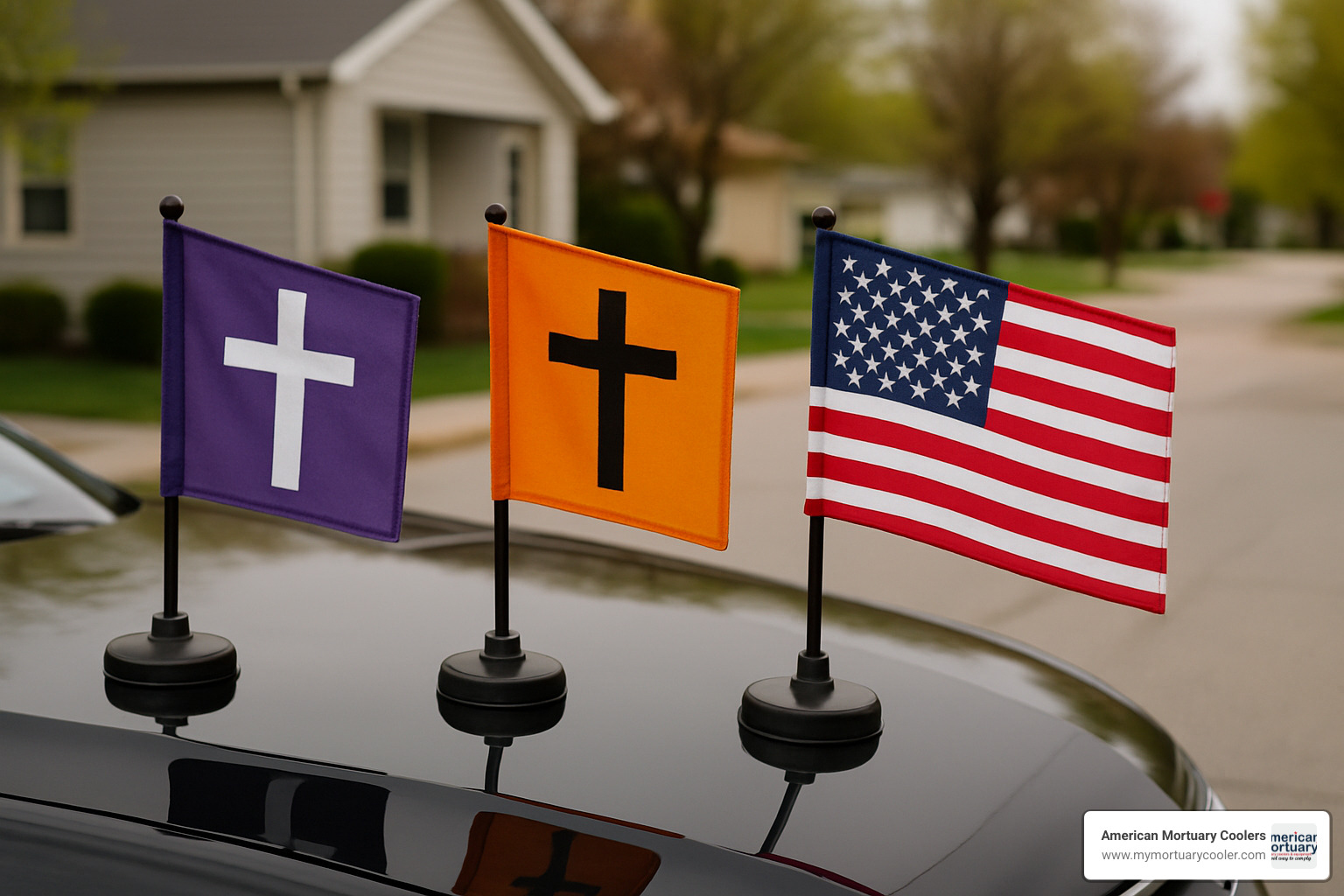
The designs and colors you'll see in most processions carry deep meaning. The traditional purple flag with a white cross remains the most common choice, symbolizing faith and spiritual transition. For increased visibility, especially in busy urban areas, the orange flag with a black cross has gained popularity. Military veterans are often honored with American flags, while Jewish and Islamic processions typically feature the Star of David or crescent symbols respectively.
| Material | Weather Resistance | Durability | Cost | Best For |
|---|---|---|---|---|
| Nylon | Excellent | Good | $11-$15/dozen | Regular use |
| 2-ply Polyester | Excellent | Excellent | $16-$30/dozen | Professional funeral homes |
| Cotton | Fair | Good | $10-$14/dozen | Indoor use/dry climates |
Color & Symbol Meanings in Funeral Flags for Cars
The colors and symbols on funeral flags for cars aren't just decorative—they speak a language of respect and tradition that goes back generations.
Black immediately signals mourning in Western cultures. It's the color that tells passing motorists "this is a funeral procession" without a word being spoken. When you see that somber black on a car flag, there's an instinctive understanding that calls for respect.
Purple carries a beautiful dual meaning of dignity and spiritual transition. "There's something about purple that brings comfort to families," explains Sarah, a funeral director from Tennessee. "It acknowledges the pain of loss while pointing to something beyond it—that spiritual journey many believe their loved one is now taking."
Orange might seem like an unusual choice for something as solemn as a funeral, but its practicality has made it increasingly common. In foggy conditions or busy highway processions, the high visibility of orange funeral flags for cars helps keep the motorcade intact and safe.
The symbols chosen for these flags hold deep personal meaning for many families. The Christian cross, Jewish Star of David, and Islamic crescent all provide spiritual comfort during a difficult time. For veterans, seeing the American flag flutter above the vehicles can be a powerful final salute to their service.
Custom Funeral Car Flags
Families today often want something uniquely meaningful to honor their loved one, which is why custom funeral flags for cars have grown in popularity.
Digital printing technology has opened up wonderful possibilities—from reproducing a loved one's favorite photograph to incorporating symbols of their lifelong passions or organizational affiliations. I once worked with a family who created flags featuring their father's beloved classic car, which led his funeral procession in a touching tribute to his lifelong hobby.
Embroidered emblems offer a more traditional, premium look that many families prefer. The raised texture and craftsmanship of embroidery brings a sense of dignity that printed flags sometimes can't match.
Photo memorial flags perhaps create the most personal connection, featuring an actual image of the deceased alongside their name and dates. While these custom options typically take 12-21 business days to produce and cost more (usually $19-$30 per flag), families often find them worth the investment.
"Custom flags become keepsakes after the service," notes Robert, a funeral director from New York. "I've had families frame them or display them alongside other memorial items. They're not just for the procession—they become part of remembering."
If you're interested in creating personalized flags for your loved one's service, services like Design your own custom car flags offer user-friendly platforms to develop meaningful tributes that honor your loved one's unique life and legacy.
Attaching Funeral Flags to Vehicles Safely
Securing funeral flags for cars properly ensures they stay in place throughout the entire procession while protecting vehicle finishes. After all, the last thing anyone needs during a solemn occasion is a flag flying off on the highway or scratching a family member's car.
Magnetic Staff Mounts
The most popular attachment method uses strong magnets wrapped in protective material that won't scratch your vehicle's paint. These magnets form the base for a lightweight pole (staff) that lifts the flag above the roof for maximum visibility.
For those breezy cemetery locations or highway processions, double-magnet bases provide extra stability by distributing the flag's weight across two contact points. A funeral director in Chicago told us, "Double magnets are absolutely essential when we're conducting services during our notorious windy days—they're the difference between dignified processions and flags tumbling down Lake Shore Drive."
Quality funeral flags for cars feature rust-proof poles made from aluminum or coated metal, ensuring they won't leave unsightly rust stains on vehicles, even during those unexpected funeral-day rain showers.
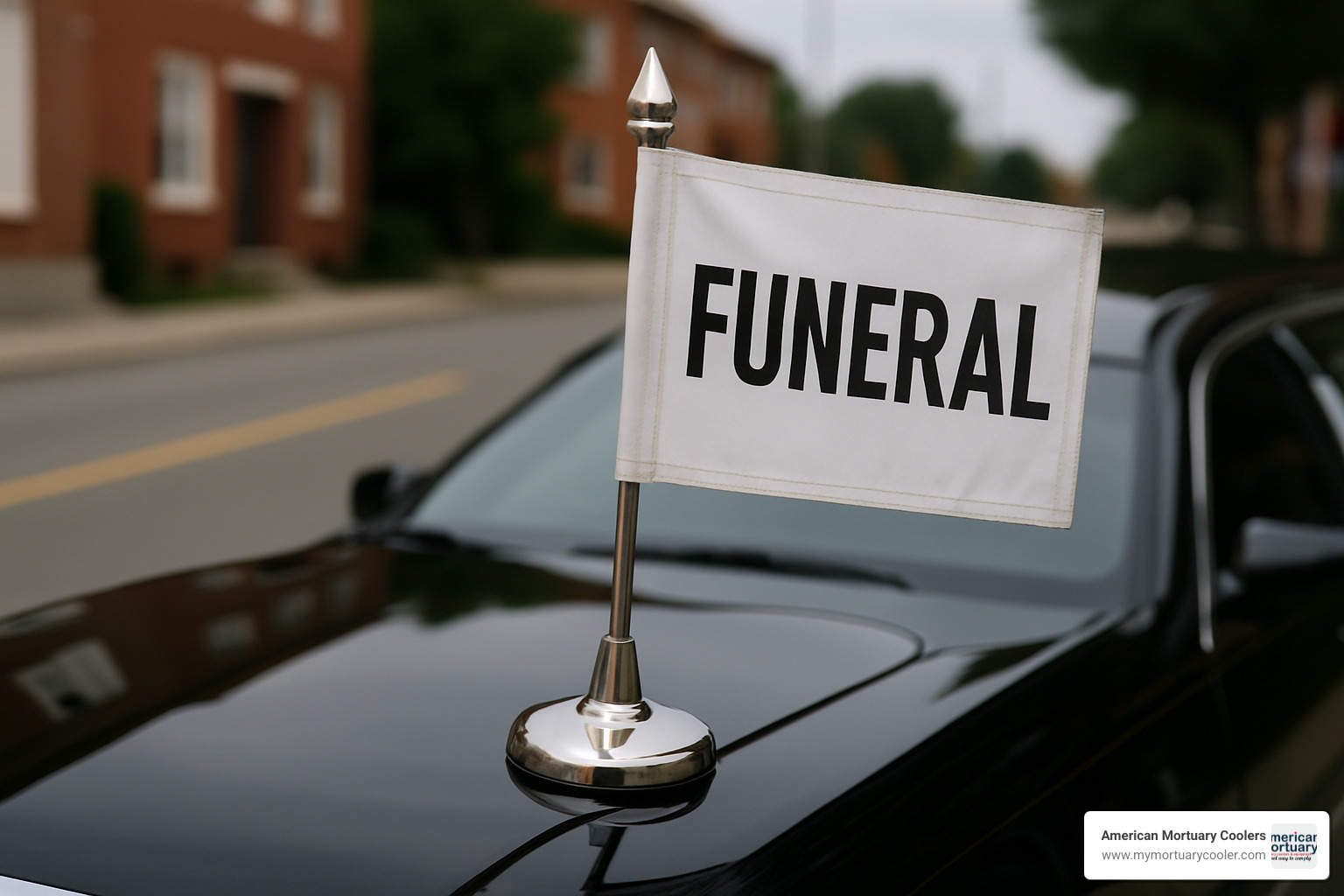
Step-by-Step Guide for Magnetic Mounts
Before mounting any funeral flags for cars, take a moment to clean the roof surface with a dry cloth. This simple step removes dust or grit that might scratch the paint under pressure from the magnet—something families will appreciate when they return their vehicles home after the service.
Position the magnetic base on a flat section of the metal roof, avoiding sunroofs, moonroofs, or curved areas where the magnet can't make full contact. Give the flag a gentle tug to confirm the magnet has formed a secure connection with the vehicle.
Most magnetic funeral flags for cars are designed for city driving speeds under 45 mph. For highway processions, remind drivers to maintain moderate speeds—a respectfully slow pace not only prevents flag detachment but also maintains the dignity of the procession.
When the service concludes, remove the flag by lifting straight up rather than sliding it, which could potentially leave fine scratches in the paint. One funeral assistant shared, "I always tell families to think of it like removing a bandage—quick and straight up is best."
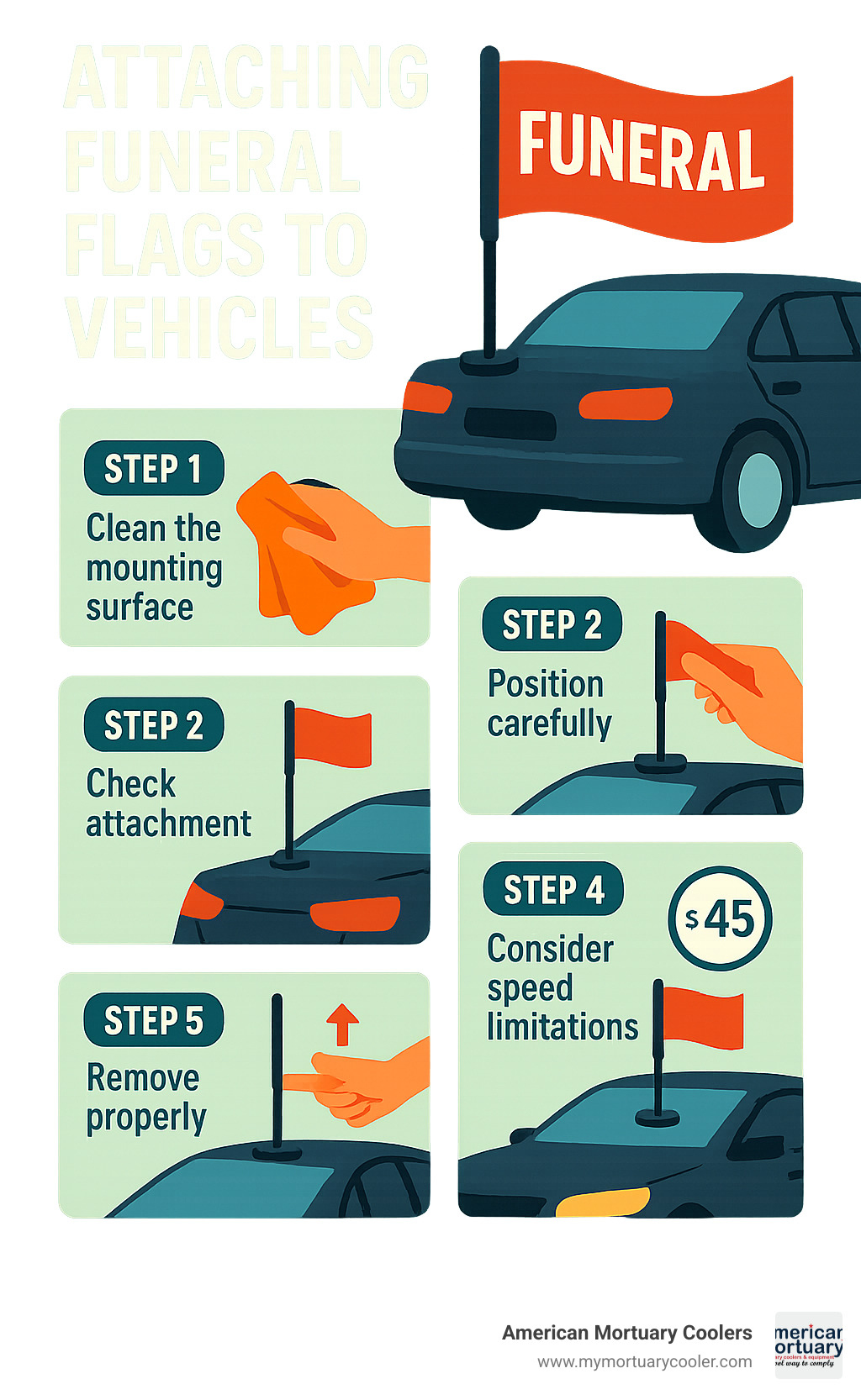
Alternative Mounting Options for Funeral Flags for Cars
With modern vehicles increasingly built with aluminum, fiberglass, or carbon fiber components, magnetic mounts aren't always an option. Thankfully, several alternatives exist:
Window clip-on poles offer a practical solution for non-magnetic roofs. Simply lower the window slightly, position the clip, then raise the window to secure it in place. These work beautifully on any vehicle regardless of roof material.
Suction cup banners attach to any smooth surface—windows, trunk lids, or rear panels—making them versatile options for virtually any vehicle in the procession. The strong suction creates a secure temporary bond that releases cleanly after the service.
Mirror wraps provide a more subtle marking option, covering side mirrors with respectful fabric markers. These are particularly popular for family members who prefer a less conspicuous way to identify their vehicle as part of the procession.
A funeral director from Columbia, SC shared this practical wisdom: "We always keep a variety of mounting options in our preparation room. Modern vehicles with carbon fiber and aluminum components are becoming more common, especially in upscale communities. Having alternatives ready shows families we've thought of everything during their difficult time."
Etiquette, Traditions & Legal Considerations
When it comes to funeral flags for cars, there's a blend of unwritten rules, heartfelt traditions, and actual legal requirements that vary widely across the country. Understanding these nuances helps ensure the procession honors the deceased with proper dignity and respect.
Procession Order and Flag Protocol
The dance of vehicles in a funeral procession follows time-honored choreography. The hearse leads the way, carrying the deceased on their final journey. Right behind follows the family limousine, with other mourners' vehicles trailing in order of closeness to the family.
The lead car often displays distinctive funeral flags for cars that might include text reading "FUNERAL" or "LEAD CAR" to clearly mark its role in guiding the procession. This visual cue helps both participants and other motorists understand the procession's structure.
Most funeral directors advise participants to keep headlights on throughout the procession, even in bright daylight. This practice dates back decades and serves as another visual signal to other drivers. Vehicles should maintain a respectfully close distance to one another – close enough to maintain the integrity of the procession, but never so close as to compromise safety.
As one funeral director from Ohio told me, "The silence of a funeral procession speaks volumes. We always remind participants to avoid using horns, as the quiet progression of vehicles itself commands a certain respect from onlookers."
Legal Considerations
The legal status of funeral processions might surprise you – it varies dramatically depending on where you are. In Pennsylvania, for example, Title 75 PA §3107 actually grants funeral processions the right-of-way through intersections once the lead vehicle has legally entered, allowing the entire motorcade to proceed together regardless of traffic signals changing.
According to comprehensive research on state laws, 38 states have enacted specific statutes addressing funeral processions, but the details differ significantly:
"We operate funeral homes in three counties," explains a director from Pittsburgh, "and I can tell you that the rules literally change at county lines. We always take time to brief our drivers on local requirements before we head to the cemetery."
Some jurisdictions require all vehicles to display funeral flags for cars to qualify for special traffic considerations, while others mandate additional markers like headlights or hazard lights. In certain areas, police escorts are required for the procession to have legal standing at all.
For funeral professionals managing various aspects of services, we've gathered additional information about funeral vehicle options that works hand-in-hand with the use of funeral flags for cars.
Global Traditions Involving Funeral Flags for Cars
The way we mark vehicles in funeral processions reflects our cultural approach to honoring those who've passed, and these traditions are wonderfully diverse around the world:
In the United Kingdom, black flags remain the traditional choice, often complemented by formally dressed chauffeurs in black attire leading the procession. Many West African communities incorporate vibrant kente cloth patterns or symbolic colors on vehicles, representing the deceased's tribal connections or social standing within the community.
Throughout Latin America, white ribbons or flags symbolize the purity and peace of the soul's journey, while in Japanese customs, white serves as the traditional color of mourning, with white flags or ribbons marking vehicles in the procession.
"We maintain flags representing at least six different cultural traditions," shares a funeral director serving diverse communities in Los Angeles. "When families see their cultural symbols respected during such a difficult time, it provides meaningful comfort when they need it most."
Common Procession Mistakes to Avoid
Even with the best intentions, there are several missteps that can diminish the dignity of a funeral procession. When using funeral flags for cars, be mindful to avoid:
Driving too quickly not only risks flag detachment but disrupts the solemnity of the occasion. Funeral processions traditionally move at a measured, dignified pace that allows for reflection.
Using inconsistent religious symbols throughout the procession can appear disrespectful. Always ensure all flags align appropriately with the deceased's faith tradition or personal beliefs.
Displaying damaged flags with tears, fading, or soiling diminishes the ceremony's dignity. A seasoned funeral director in Memphis told me, "We inspect all our flags before every service. A tattered flag sends the wrong message about how we honor the deceased."
Remember to remove flags promptly after arriving at the final destination. Leaving them attached to vehicles after the procession concludes is generally considered inappropriate.
For visual harmony, aim for consistent placement of flags across all vehicles, typically positioned on the driver's side of the roof whenever possible.
By observing these traditions and considerations, funeral flags for cars serve their purpose beautifully – uniting the procession, communicating its purpose to the public, and honoring the deceased with dignity and respect.
Buying, Customizing & Caring for Funeral Car Flags
When it comes to funeral flags for cars, most funeral homes prefer buying in bulk to ensure they have enough for every service. The industry standard is dozen-count bundles, making it easy to outfit an entire procession. The price range reflects the quality and craftsmanship you're getting:
- Basic nylon flags with magnetic mounts start around $11.40-$14.50 per dozen—perfect for funeral homes just starting out.
- Premium weather-resistant flags run $16.50-$30 per dozen, offering better durability for homes conducting frequent services.
- Custom-printed flags with personalization range from $19.95-$230 per dozen, depending on how intricate the design work is.
If you're considering custom funeral flags for cars, remember to plan ahead. Most suppliers need 12-21 business days for production. One funeral director told me, "I learned the hard way to order custom flags well in advance. A family requested personalized flags with their loved one's photo, and the rush fees nearly doubled our costs."
Many suppliers understand the financial realities of running a funeral home and offer flexible payment options. Three-payment plans are common, helping you maintain proper inventory without straining your cash flow.

Between services, proper storage makes all the difference in how long your funeral flags for cars will last. Purpose-designed carriers and storage tubes protect your investment by preventing creasing, fading, and damage. These practical carriers typically hold up to two dozen flags and include separate compartments for bases and staffs—keeping everything organized and ready for the next service.
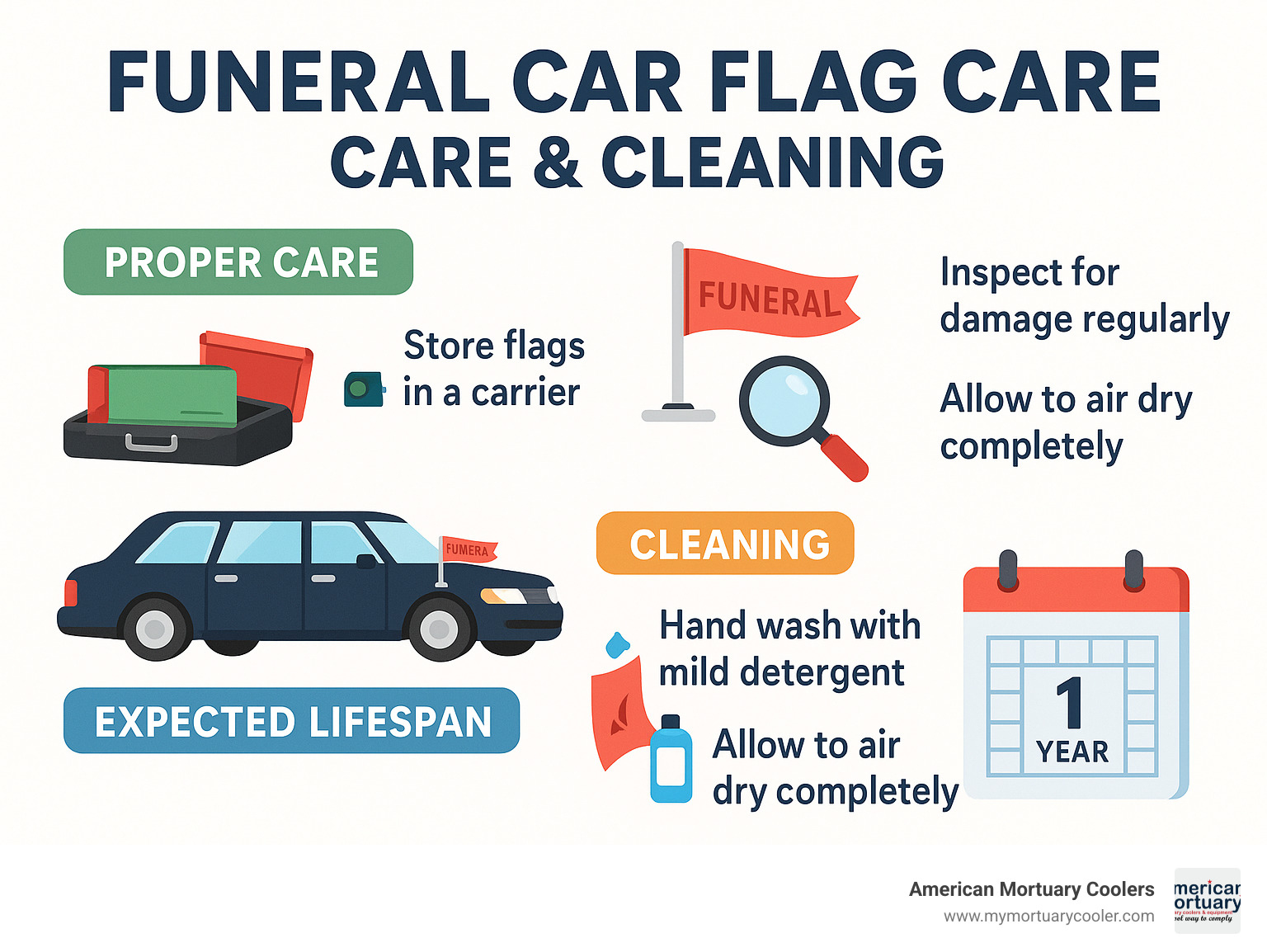
Where to Purchase & Typical Costs
You have several good options when shopping for funeral flags for cars:
Online funeral supply companies offer the widest selection of designs and mounting options. Their bulk pricing is usually competitive, and you can browse a variety of styles from the comfort of your office.
Local flag shops might have a more limited selection of funeral-specific designs, but they often shine when it comes to custom options with faster turnaround times. Plus, there's something to be said for supporting local businesses in your community.
Funeral service wholesalers provide excellent pricing for funeral homes purchasing in volume. If you conduct multiple services weekly, this might be your most economical option.
Price-wise, you'll find economy magnetic flags for $11.40-$14.50 per dozen, while premium weather-resistant flags run $16.50-$30 per dozen. Lead car flag sets (with "FUNERAL" text) typically cost $16.50-$25 each, and custom-printed photo or logo flags range from $19.95-$29.95 each, with discounts available for larger orders.
"Invest in quality flags that will last," advised a funeral director from Chicago I spoke with recently. "Cheap flags fade quickly and can tear during use, which doesn't present the professional image families expect. We replaced our economy flags with premium weather-resistant ones and they've lasted five times longer."
Best Practices for Maintenance
Taking good care of your funeral flags for cars extends their lifespan considerably. Here's how to keep them looking dignified service after service:
When flags become soiled, hand wash them with mild soap and cool water. Avoid harsh detergents or bleach that can damage the vibrant colors that make these flags meaningful. Always allow flags to air dry completely before storage—damp flags quickly develop mildew, which can ruin them permanently.
Those annoying fold lines that make flags look unprofessional? A light steaming (never ironing) before use works wonders. The magnetic bases need attention too—simply wipe them with a damp cloth to remove road debris that accumulates during processions. Store bases separately from electronic devices and credit cards to prevent magnetic interference.
Make inspection part of your pre-service routine. Check flags for fading, fraying, or damage, and replace as needed. As one Dallas funeral director shared, "We keep a small steamer in our preparation room to quickly remove storage creases from flags before each service. It takes just seconds but makes the flags look much more professional."
Selecting the Right Material & Mount
Choosing the right funeral flags for cars depends on several practical factors:
Consider your local weather conditions first. If you're in Florida or Arizona with intense sun, or the Pacific Northwest with frequent rain, premium weather-resistant nylon or polyester flags are worth the extra investment. The UV-resistant stitching and fade-resistant dyes maintain a respectful appearance much longer in harsh conditions.
The types of vehicles in your processions matter too. Traditional hearses and limousines with metal roofs work beautifully with magnetic mounts. However, many modern vehicles feature aluminum or composite panels where magnets won't stick. For these, window clips or suction mounts are necessary. If your processions include motorcycle escorts, specialized handlebar or antenna mounts ensure these important vehicles are properly identified too.
For longer processions, especially in windy conditions, double-magnetic bases provide extra security. Nothing disrupts the solemnity of a funeral procession like a flag coming loose on the highway.
Don't forget to consider your facility's storage space when selecting flag quantities and storage solutions. Even the best flags can become damaged if improperly stored between services.
For funeral homes looking to create a cohesive, professional appearance across all aspects of their service, we offer information about choosing the right registration stand to complement your funeral flags for cars.
Frequently Asked Questions about Funeral Flags for Cars
Do I need special permission to use funeral flags for cars on public roads?
No special permits are typically required to display funeral flags for cars during a legitimate funeral procession. The flags themselves are perfectly legal to use on public roads. That said, local regulations can vary significantly when it comes to procession privileges like proceeding through red lights.
In some cities and towns, funeral processions must be led by licensed funeral directors or police escorts to receive any traffic exemptions. As one funeral director from Atlanta told us, "While we don't need permits for the flags themselves, we do coordinate with local police for larger processions, especially when crossing busy intersections or traveling through multiple jurisdictions."
For the best legal protection, make sure all vehicles in your procession display consistent funeral flags for cars, drive with headlights on, and maintain a close (but safe) following distance. This unified appearance helps establish your group as an official procession in the eyes of both law enforcement and other motorists.
Can funeral flags for cars be reused for multiple services?
Absolutely! Quality funeral flags for cars are specifically designed for reuse across many services. The premium flags made from weather-resistant nylon or polyester typically last through hundreds of processions when properly maintained and stored.
To get the most life from your funeral flags, clean them promptly if they become soiled, store them in protective tubes or carriers between services, and inspect them regularly for damage. It's also wise to keep spare flags on hand for unexpected replacements.
A funeral director from Johnson City, Tennessee shared this practical advice: "We've been using the same set of premium flags for over two years now, rotating them through hundreds of services. The key is proper storage and handling—we train all our staff on correct flag protocols."
With proper care, your investment in quality funeral flags will serve your establishment for years, providing a dignified touch to countless memorial processions.
How fast can I drive with magnetic funeral flags attached?
Most magnetic funeral flags for cars are designed with city driving in mind, generally safe at speeds between 25-45 mph. Manufacturers typically recommend not exceeding 45 mph with standard magnetic mounts. At higher speeds, the increased wind resistance can overcome even strong magnetic bonds, potentially causing the flag to detach.
For processions that will travel on highways or in particularly windy conditions, consider using double-magnetic bases that provide increased holding power. You might also advise drivers to maintain reduced highway speeds (45-55 mph) when flags are attached, or switch to alternative mounting methods like window clips for high-speed segments.
One funeral director from Dallas shared a cautionary tale: "We've had flags detach at highway speeds, which is not only potentially dangerous but disrupts the dignity of the procession. We now use double-magnetic bases for all highway processions and advise drivers to keep speeds moderate."
The last thing anyone wants during a solemn procession is a flag flying off and causing a distraction or hazard, so erring on the side of caution with speed is always the respectful choice.
Conclusion
As we've explored throughout this guide, funeral flags for cars are much more than simple decorative elements – they're meaningful symbols that honor the departed while serving the practical purpose of keeping processions organized and visible.
Whether you're choosing traditional designs with religious symbols, high-visibility options for urban settings, or personalized flags that celebrate a unique life, these dignified markers help create a cohesive final journey that respects both the deceased and their loved ones.
When selecting funeral flags for cars for your funeral home or personal needs, take time to consider what will work best for your specific circumstances. Think about your local weather patterns, the types of vehicles typically used in your processions, and the cultural or religious preferences of your community. Investing in quality flags and proper storage solutions now will ensure these important symbols remain pristine and ready for service when families need them most.
Proper flag selection, installation, and maintenance might seem like small details, but they make a significant difference in how smoothly and respectfully a funeral procession unfolds. As one funeral director shared with us, "When everything is coordinated and professional – from the flags to the vehicles to the procession timing – families notice. It gives them one less thing to worry about during an already difficult time."
At American Mortuary Coolers, we understand the importance of every detail in creating dignified, meaningful funeral services. While we're known for our custom mortuary coolers, we're passionate about supporting funeral professionals with all aspects of their important work – including procession management and proper use of funeral flags for cars.
For those looking to improve their funeral service offerings with complementary equipment and supplies, we invite you to explore our complete range of mortuary solutions that work alongside funeral flags for cars to create seamless, professional services. Learn more about our mortuary solutions and how we can support your commitment to providing families with respectful, dignified final tributes.
The care you put into every aspect of your funeral services – from the selection of funeral flags for cars to the precision of your procession management – speaks volumes about your dedication to the families you serve during their most difficult moments.



















